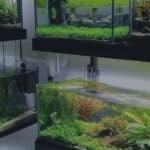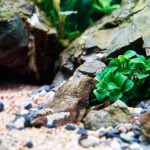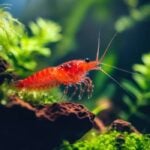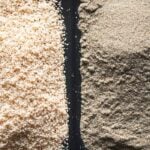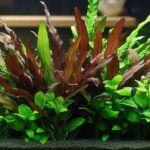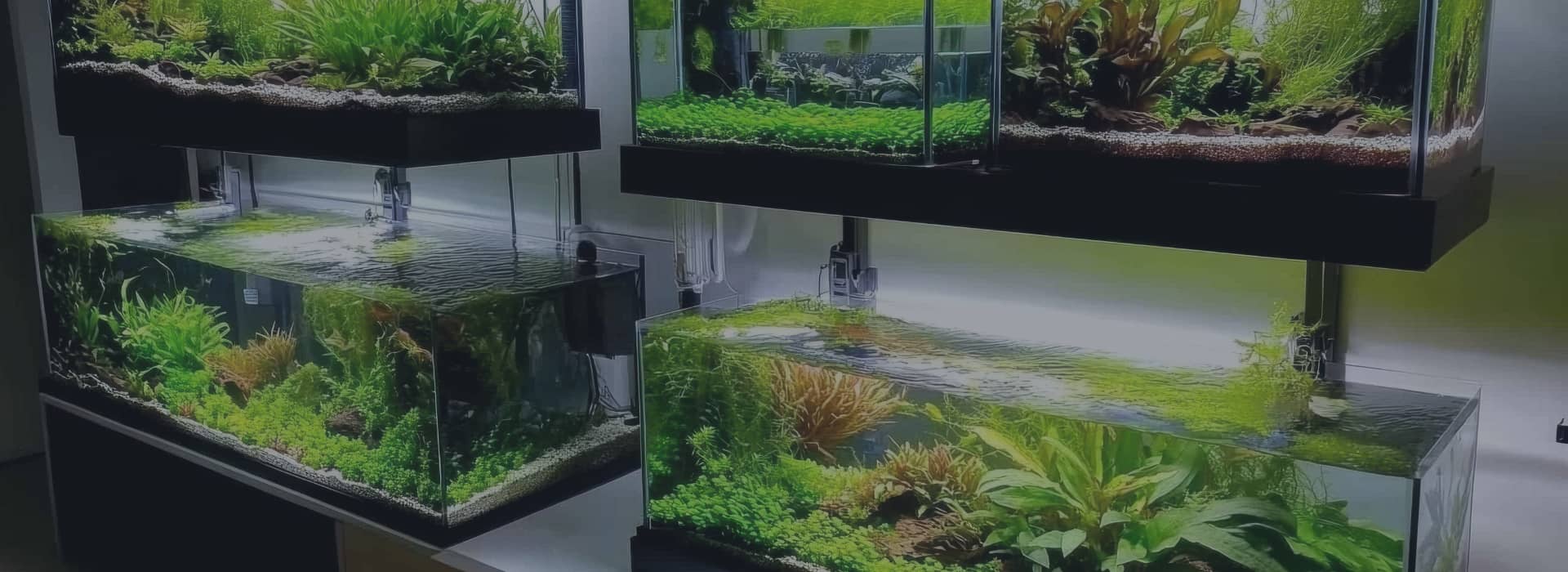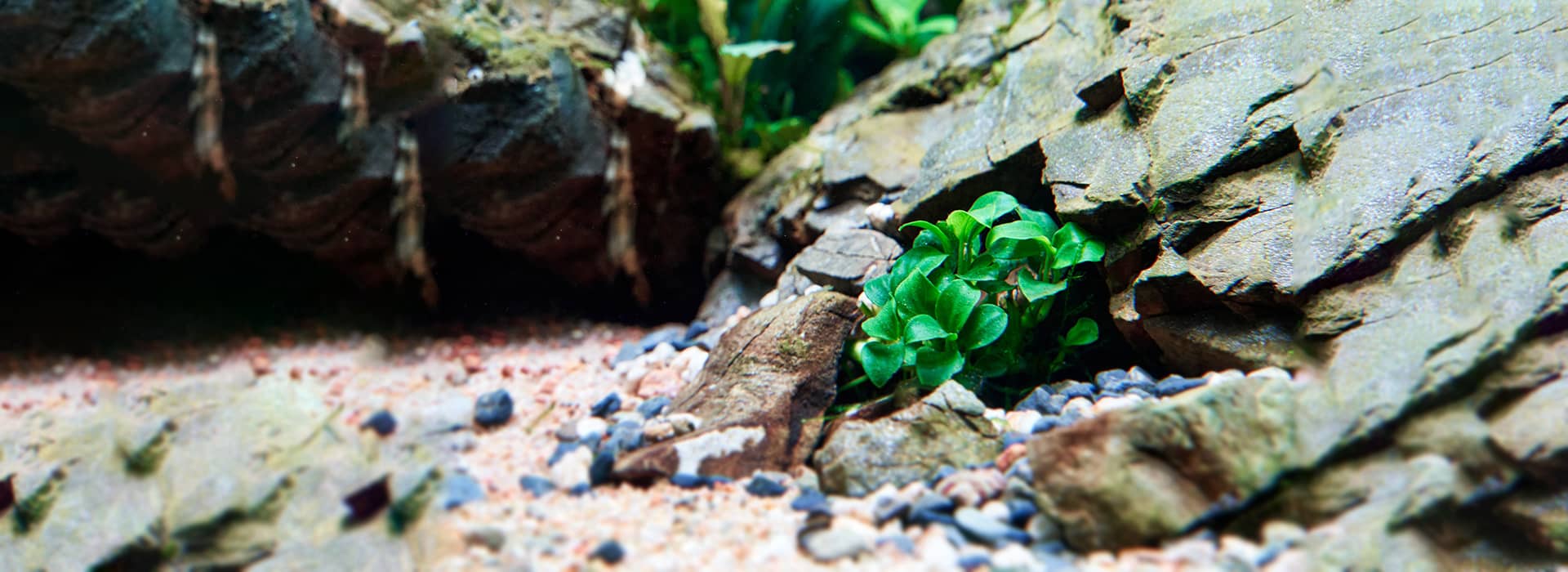Aquascaping is often seen as a daunting and complex hobby and wrongly believed to be inaccessible to beginners. However, contrary to this common perception, aquascaping offers a fantastic creative outlet and is very much within what is possible for newcomers. With a combination of patience, creativity, and some basic knowledge, beginners can dive into this captivating world and create their own breath-taking aquatic masterpieces. Today, we will explore the different aquascape styles that debunk the misconception that this part of the hobby is only reserved for seasoned experts.
The 10 aquascape ideas for beginners we’ll be looking at are
- Low-Tech Aquascape
- Nano Aquascaping
- Jungle Aquascape
- Minimalist Aquascaping
- Anubias Aquascaping
- Moss Aquascaping
- No Constraints Aquascaping
- Budget Aquascaping
- Carpet Aquascaping
- Artificial Aquascaping
Let’s take a detailed look at each of them
Low-Tech Aquascape:
Low-tech aquascaping is a wonderful way to create a natural and vibrant underwater landscape without the need for complex equipment. By using hardy plants and minimal technology, you can achieve a stunning aquatic environment that thrives with minimal maintenance. Here’s a guide to setting up a low-tech aquascape:
Ideal Plants: Choose aquatic plants that are suitable for low-tech setups. Examples include Java moss, Java fern, Anubias, Cryptocoryne, and Vallisneria. These plants can tolerate lower light levels and don’t require CO2 injection or high-intensity lighting.
Materials Required:
- Aquarium: Select an appropriate-sized aquarium, preferably with a capacity of 40 to 80 litres or 10 to 20 gallons, depending on your space and preferences.
- Substrate: Choose a nutrient-rich substrate like aquarium soil or gravel. This provides essential nutrients for plant growth.
- Lighting: Opt for a low to medium light fixture. LED lights designed for planted aquariums work well for low-tech setups.
- Decorations: Incorporate rocks, driftwood, and stones to create a natural look and provide hiding places for fish and invertebrates.
- Water Conditioner: Use a water conditioner to remove chlorine and chloramine from tap water before adding it to the aquarium.
- Heater and Thermometer: Depending on the species of fish you plan to keep, a heater may be required to maintain the appropriate temperature. A thermometer helps monitor the water temperature.
- Liquid Fertiliser: Although not essential, a low-tech liquid fertiliser can provide additional nutrients to support plant growth.
Setting It Up:
- Rinse the substrate under running water to remove any dust or debris and spread it evenly across the bottom of the aquarium.
- Wet the substrate to make the planting process easy.
- Arrange rocks, driftwood, and stones in a visually pleasing manner. Ensure they are stable and won’t shift.
- Install the lighting fixture above the aquarium, considering the light requirements of your chosen plants.
- Plant your selected aquatic plants, burying their roots into the substrate. If using plants with rhizomes, don’t bury the rhizomes completely. Space the plants out to leave enough space for growth and ensure they have adequate access to light.
- Fill the tank with water, treating it with a water conditioner to make it safe for fish and plants
- Add any fish, invertebrates, or snails that are compatible with the plants and will contribute to the overall balance of the ecosystem.
- Turn on the heater if necessary, setting it to the appropriate temperature.
- Regularly monitor water parameters such as temperature, pH, and ammonia levels. Perform water changes as needed and dose liquid fertiliser according to the manufacturer’s instructions.
Low-tech aquascaping provides a rewarding and environmentally-friendly approach to aquarium design. With careful plant selection and minimal technology, you can create a captivating underwater world that brings nature’s beauty into your home.
Nano Aquascape:
Nano aquascaping is a captivating form of aquascaping that focuses on creating intricate and visually appealing underwater landscapes in small aquariums. With limited space, nano tanks offer a unique challenge to design a miniaturised ecosystem. Here’s a guide to setting up a nano aquascape:
Ideal Plants: Opt for small and compact aquatic plants that won’t outgrow the limited space. Some suitable choices include dwarf hairgrass, HC Cuba, Staurogyne repens, Anubias nana petite, and Rotala sp. ‘Green.’
Materials Required:
- Nano Aquarium: Choose a small-sized aquarium with a capacity of around 20 to 40 litres or 5 to 10 gallons. Cube-shaped tanks are popular for nano aquascapes.
- Substrate: Use a nutrient-rich substrate designed for planted aquariums. A fine-grain substrate like aqua soil or specialised plant substrates works well in nano tanks.
- Lighting: Select a compact LED light fixture that provides sufficient light for plant growth. Adjustable lights with low to medium intensity are suitable for nano aquascapes.
- Decorations: Incorporate miniature rocks, driftwood pieces, and small ornaments to create scale-appropriate features and focal points.
- Water Conditioner: Treat tap water with a water conditioner to neutralise chlorine and other harmful chemicals before adding it to the aquarium.
- CO2 System (optional): In some cases, a small CO2 system may be used to enhance plant growth. However, nano tanks can thrive without CO2 injection and you don’t need it if it is outside the scope of what you can do for the aquarium.
- Liquid Fertiliser: A liquid fertiliser designed for small aquariums can be used to supplement the nutrient requirements of the plants.
Setting It Up:
- Rinse the substrate thoroughly under running water to remove any impurities, and carefully spread it in a shallow layer at the bottom of the aquarium.
- Arrange the rocks, driftwood, and ornaments in a visually pleasing manner, considering the limited space available. Aim for a balanced composition and create depth by placing taller items towards the back. Less is more here when it comes to the number of different aquascaping elements needed.
- Install the LED light fixture above the aquarium, adjusting its height to provide adequate light coverage for the plants.
- Add just enough water to wet the substrate. Plant the selected aquatic plants using tweezers or long, thin planting tools. Take care to space them appropriately, allowing for growth and preventing overcrowding.
- Fill the tank fully with water, ensuring that it is at the right temperature and treated with a water conditioner.
- If using a CO2 system, install it according to the manufacturer’s instructions and set the CO2 levels to a low intensity suitable for small tanks.
- Fill the aquarium with fish, invertebrates, or shrimp species that are compatible with the size and conditions of the nano tank.
- Monitor water parameters regularly, including temperature, pH, and ammonia levels. Perform regular water changes and dose liquid fertiliser as recommended for small aquariums.
Nano aquascaping allows for creativity within the constraints of a small aquarium. It is a great option for anyone with limited space, limited budget, or who enjoys small things.
Jungle Aquascape:
Jungle aquascaping aims to recreate the lush and dense vegetation of a tropical rainforest within an aquarium. It focuses on creating a wild and natural-looking underwater landscape with a variety of plant species. While it may look complicated, it is one of the easiest styles of aquascaping. Here’s a guide to setting up a jungle aquascape:
Ideal Plants: Choose a combination of tall, medium, and low-growing plants to mimic the layers found in a jungle. Ideal plant choices include Amazon swords, Cryptocoryne species, Rotala rotundifolia, Java fern, Anubias barteri, and various mosses like Christmas moss and Java moss.
Materials Required:
- Aquarium: Select a spacious aquarium with a larger capacity, preferably 80 to 200 litres or 20 to 50 gallons, to provide ample space for the plants to grow.
- Substrate: Use a nutrient-rich substrate like aqua soil or specialised plant substrates. Adding a layer of fine gravel or sand on top can enhance the natural look.
- Lighting: Install a high-intensity LED light fixture or fluorescent lights to provide sufficient light penetration for the plants.
- Decorations: Incorporate driftwood, rocks, and branches to create a natural and jungle-like environment. These structures also serve as anchors for plants like mosses and ferns that don’t need to be planted in the substrate.
- Water Conditioner: Use a water conditioner to treat tap water and remove chlorine or other harmful chemicals before adding it to the aquarium.
- CO2 System (optional): A CO2 system can be beneficial for promoting robust plant growth in a jungle aquascape. However, it is not always necessary and depends on the specific plant selection and lighting intensity. You can start without one and once you gain more experience, you can start thinking about investing in a CO2 system.
- Liquid Fertiliser: A comprehensive liquid fertiliser containing essential nutrients can be used to supplement the plants’ needs.
Setting It Up:
- Rinse the substrate thoroughly to remove any debris, and spread it evenly across the bottom of the aquarium.
- Arrange the driftwood, rocks, and branches in a way that creates an appealing layout with varied heights and hiding places for fish.
- Install the lighting system above the aquarium, adjusting the intensity and duration based on the light requirements of the selected plants.
- Plant the taller species towards the back of the aquarium, gradually working towards the foreground with medium and low-growing plants. Attach epiphytic plants like mosses and ferns to the driftwood and rocks using fishing line or glue.
- Fill the tank with water, ensuring it is treated with a water conditioner and at the desired temperature.
- If using a CO2 system, set it up according to the manufacturer’s instructions and adjust the CO2 levels based on plant growth and water parameters.
- Introduce fish and invertebrates that thrive in a jungle-like environment, such as tetras, gouramis, smaller catfish, and shrimp species.
- Regularly monitor water parameters, conduct routine maintenance such as trimming plants to prevent overcrowding, and dose liquid fertiliser as needed.
The cool thing about a jungle aquascape is that it is captivating and vibrant while being very forgiving of mistakes beginners can make. Their lush greenery is reminiscent of a tropical rainforest. With careful plant selection, creative hardscape arrangements, and proper maintenance, you can create a thriving jungle oasis in your own aquarium.
Minimalist Aquascape:
Minimalist aquascaping is a clean and simple approach to aquarium design that focuses on creating a visually striking yet understated aquatic landscape. It emphasises open space, clean lines, and a minimal number of carefully chosen elements. Here’s a guide to setting up a minimalist aquascape:
Ideal Plants: Choose plants with a sleek and minimalist appearance, such as Java moss, Anubias nana, Bucephalandra, Cryptocoryne wendtii, and Vallisneria spiralis. Opt for species that grow slowly and require minimal pruning.
Materials Required:
- Aquarium: Select a sleek and rectangular aquarium with clean lines. The size and dimensions can vary depending on your preferences and space availability.
- Substrate: Use a fine-grain substrate like sand or gravel to create a clean and minimalist look. Consider using a dark-coloured substrate to enhance the contrast with the plants.
- Lighting: Install a moderate-intensity LED light fixture or a minimalist-style pendant light to illuminate the aquarium evenly without overwhelming the space.
- Decorations: Keep the decorations minimal, focusing on a few key elements like rocks or driftwood. Choose materials with clean and smooth lines to complement the minimalist aesthetic.
- Water Conditioner: Use a water conditioner to remove chlorine and other harmful chemicals from tap water before adding it to the aquarium.
- Liquid Fertiliser (optional): Depending on the plant selection, a low-dose liquid fertiliser may be used to provide essential nutrients for the plants.
Setting It Up:
- Rinse the substrate thoroughly to remove any debris and evenly spread it across the bottom of the aquarium.
- Fill the tank partially with water, treating it with a water conditioner to make it safe for fish and plants.
- Arrange the chosen decorations sparingly, focusing on achieving a balanced and visually appealing layout. Consider the rule of thirds or asymmetry to create an eye-catching design.
- Install the lighting fixture, ensuring it provides adequate light coverage for the plants and enhances the minimalist aesthetic.
- Plant the selected aquatic plants strategically, leaving open spaces for negative space and visual breathing room. Trim any excess foliage to maintain a neat appearance.
- Fill the tank completely with water.
- If using liquid fertiliser, follow the manufacturer’s instructions for dosing and add it to the aquarium accordingly.
- Introduce a small number of fish or invertebrates that complement the minimalist design, such as a small school of tetras, guppies, or a few shrimp.
- Regularly monitor water parameters, conduct water changes as necessary, and trim plants to maintain the desired minimalist aesthetic.
Minimalist aquascaping offers a serene and refined aesthetic that emphasises simplicity and elegance. This style is easy on the pockets and doesn’t require a lot of effort to setup or maintain. By selecting the right plants, maintaining clean lines, and incorporating a minimalist design philosophy, you can create a captivating and tranquil underwater world.
Anubias Aquascape:
Anubias aquascaping focuses specifically on showcasing the beauty and versatility of Anubias plants. These hardy and low-maintenance aquatic plants are popular choices for aquascaping due to their striking leaf shapes and ability to thrive in a variety of conditions. Here’s a guide to setting up an Anubias aquascape:
Ideal Plants: As the centrepiece of the aquascape, select different Anubias species such as Anubias barteri, Anubias nana, Anubias coffeefolia, or Anubias petite. These plants have varying leaf sizes and textures, adding visual interest to the layout.
Materials Required:
- Aquarium: Choose a suitable-sized aquarium that complements the desired scale of your aquascape. Consider a tank with a capacity of 40 to 80 litres or 10 to 20 gallons, depending on available space.
- Substrate: Anubias plants are typically epiphytic and don’t require substrate planting. However, you can use a thin layer of sand or gravel as a substrate for aesthetic purposes.
- Lighting: Install a moderate-intensity LED light fixture that provides sufficient light for Anubias plants. These plants thrive in low to moderate lighting conditions, so avoid high-intensity lights that can lead to algae problems.
- Decorations: Select driftwood or rocks to create hardscape features for attaching the Anubias plants. These materials should provide surfaces for the plants to anchor onto and enhance the natural look of the aquascape.
- Water Conditioner: Use a water conditioner to remove chlorine and other harmful chemicals from tap water before adding it to the aquarium.
- Liquid Fertiliser (optional): Anubias plants have low nutrient requirements, so fertilisation is usually not necessary. However, if desired, a diluted liquid fertiliser can be used sparingly.
Setting It Up:
- Rinse the substrate (if using) to remove any debris and add it to the aquarium, creating a thin layer.
- Fill the tank with water, treating it with a water conditioner to make it safe for fish and plants.
- Arrange the chosen hardscape elements (driftwood or rocks) in a visually appealing manner, creating spaces for attaching the Anubias plants.
- Attach the Anubias plants to the hardscape using thread, fishing line, or specialised plant glue. Position them at different heights and angles to add depth and dimension to the aquascape.
- Install the lighting fixture above the aquarium, ensuring it provides even coverage over the Anubias plants.
- Add any desired fish or invertebrates that are compatible with the Anubias plants and the chosen aquarium conditions.
- Monitor water parameters regularly and maintain them within the appropriate range for the chosen fish and plants.
- Perform regular maintenance, such as removing algae and trimming any dead or yellowing leaves from the Anubias plants.
Anubias are a godsend for beginner aquascapes. They are easy to setup, readily available, and the aquascapes they produce are some of the toughest while still being great to look at.
Moss Aquascape:
Moss aquascaping focuses on utilising different varieties of moss to create lush and vibrant underwater landscapes. Mosses, like Anubias, are versatile plants that can be attached to various surfaces, making them ideal for creating intricate textures and natural-looking aquascapes. Here’s a guide to setting up a moss aquascape:
Ideal Plants: Choose different types of aquatic mosses, such as Java moss (Taxiphyllum barbieri), Christmas moss (Vesicularia montagnei), or Weeping moss (Vesicularia ferriei). These mosses are hardy and grow well in a variety of aquarium conditions.
Materials Required:
- Aquarium: Select an aquarium of your preferred size and shape. A compact and shallow tank is often suitable for showcasing the intricate details of mosses.
- Substrate: Use a fine-grain substrate like sand or gravel, or you can opt for a bare-bottom tank. Mosses can attach themselves to various surfaces and don’t necessarily require substrate planting.
- Lighting: Install a moderate-intensity LED light fixture to provide sufficient light for moss growth. Mosses can thrive under low to moderate lighting conditions.
- Decorations: Incorporate hardscape elements such as driftwood, rocks, or mesh structures that provide surfaces for the mosses to attach to and grow on. These decorations add dimension and texture to the aquascape.
- Water Conditioner: Use a water conditioner to treat tap water and remove chlorine or other harmful chemicals before adding it to the aquarium.
- Liquid Fertiliser (optional): Mosses have low nutrient requirements, but if desired, you can use a diluted liquid fertiliser to supplement their needs.
Setting It Up:
- Rinse the substrate (if using) to remove any debris and spread it evenly across the bottom of the aquarium.
- Fill the tank with water, treating it with a water conditioner to make it safe for fish and plants.
- Arrange the chosen hardscape elements (driftwood, rocks, or mesh structures) in a visually appealing manner, considering their placement for moss attachment.
- Attach the mosses to the hardscape by tying them with fishing line or using a specialised aquarium-safe glue. You can create different textures and shapes by layering and intertwining the mosses.
- Install the lighting fixture above the aquarium, ensuring it provides even coverage for the mosses.
- Add any desired fish or invertebrates that are compatible with the mosses and the chosen aquarium conditions.
- Monitor water parameters regularly and maintain them within the appropriate range for the chosen fish and plants.
- Perform regular maintenance, such as trimming any overgrown mosses and removing debris or algae.
Moss aquascapes offer a different approach to aquascaping with their captivating looks and lush green textures. You can put these plants to many creative uses which is also a great way to get more proficient at aquascaping without being overwhelmed.
Anything Goes Aquascape
An aquascape with no rules is a great way for beginners to explore their creativity and experiment with different ideas without feeling constrained by specific styles or guidelines. This type of aquascape allows for a free-flowing and organic approach, where you can let your imagination run wild. Here’s a guide to setting up a rule-free aquascape:
- Choose Your Aquarium: Select an aquarium of a size that suits your preferences and available space. Consider factors such as shape, capacity, and clarity of glass for optimal viewing.
- Substrate Selection: Choose a substrate that suits your vision and the needs of your chosen plants and livestock. Options include gravel, sand, or specialised plant substrates. Consider colours that will complement your overall design.
- Lighting: Install a lighting system that provides sufficient light intensity for the plants you plan to include in your aquascape. Research the lighting requirements of your chosen plants to ensure they thrive.
- Hardscape Elements: Introduce hardscape materials such as driftwood, rocks, or stones to add structure and visual interest to your aquascape. Arrange them according to your creative vision, experimenting with different shapes, sizes, and textures.
- Plant Selection: Choose a variety of plants that appeal to you visually and align with your desired level of maintenance. Consider plants with different leaf shapes, sizes, and colours to add diversity to your aquascape. Just make sure that they have broadly similar care requirements.
- Livestock: Decide on the type and number of fish, shrimp, or other aquatic creatures you want to keep in your aquarium. Research their compatibility and care requirements to ensure a harmonious environment.
- Water Parameters: Regularly monitor and maintain appropriate water parameters, including temperature, pH, and hardness, to ensure the health and well-being of your aquatic life.
- Maintenance and Care: Perform routine maintenance tasks such as pruning plants, cleaning the glass, and managing algae growth. Conduct regular water changes to keep water quality optimal.
- Experiment and Evolve: Embrace the freedom to experiment with different layouts, plant arrangements, and additions to your aquascape. Don’t be afraid to make changes and evolve your design over time as you learn and gain experience.
Remember, the most important aspect of a rule-free aquascape is to enjoy the process and express your creativity. Learn from your experiences, seek inspiration from other aquascapers, and let your imagination guide you to create a unique and personalised underwater world.
Budget Aquascape
Budget aquascaping allows you to create a beautiful underwater landscape while being mindful of your expenses. With careful planning and resourcefulness, you can still achieve an aesthetically pleasing aquascape without breaking the bank. Here’s a guide to setting up a budget-friendly aquascape:
Ideal Plants: Choose affordable and hardy plants that are readily available in the market. Ideal options include Java moss, Java fern, Anubias, Cryptocoryne, and Hornwort. These plants are low-maintenance and can thrive in a range of conditions.
Materials Required:
- Aquarium: Look for a second-hand or affordable aquarium of an appropriate size for your desired aquascape. Consider a smaller tank to minimise costs.
- Substrate: Use a budget-friendly substrate option such as fine gravel or sand. These options provide a functional base for your plants and won’t strain your budget.
- Lighting: Opt for affordable lighting solutions such as compact fluorescent bulbs or LED light fixtures. Look for options that offer adequate light intensity for the chosen plants.
- Decorations: Utilise natural materials like driftwood or rocks that can be collected from local sources, such as nature trails or parks. However, properly clean and sterilise them thoroughly before adding them to your aquarium.
- Water Conditioner: Invest in a quality water conditioner to treat tap water and make it safe for your fish and plants. This is a crucial step in ensuring their well-being.
- Liquid Fertiliser: While not mandatory, a basic liquid fertiliser can help provide essential nutrients for your plants. Look for affordable options that contain a balanced mix of macro and micronutrients. These tend to be quite affordable.
Setting It Up:
- Rinse the substrate thoroughly to remove any debris and add it to the aquarium, creating an even layer at the bottom.
- Arrange the chosen decorations (driftwood, rocks, etc.) to create a visually appealing layout. Be creative and experiment with different arrangements.
- Install the lighting fixture above the aquarium, adjusting its position to provide even coverage.
- Plant the chosen aquatic plants, keeping in mind their specific requirements and growth habits. Create depth and visual interest by placing taller plants towards the back and smaller ones in the foreground.
- Fill the tank with treated water, ensuring it is at the desired temperature for your chosen fish and plants. Make sure the replant anything that comes loose.
- Add fish and invertebrates that are compatible with your budget and the size of the aquarium. Research affordable options that suit your desired aquascape theme.
- Regularly monitor water parameters and perform routine maintenance tasks such as water changes, removing debris, and trimming plants as needed.
With budget aquascaping, creativity and resourcefulness are key. Explore local stores, online marketplaces, and aquarium societies for affordable plant and livestock options. DIY projects, such as making your own decorations or propagating plants, can also help reduce costs. Just make sure that everything you put in the tank is safe for the plants and fish.
Carpet Aquascape
Carpet aquascaping focuses on creating a lush carpet of plants that covers the foreground of the aquarium, resembling a vibrant and dense meadow. This type of aquascape creates a visually striking and natural-looking environment and is the perfect setup for keeping shrimps and other small invertebrates. Here’s a guide to setting up a carpet aquascape:
Ideal Plants: Select plants that are known for their carpeting ability and low-growing nature. Ideal choices include Hemianthus callitrichoides (Dwarf Baby Tears), Glossostigma elatinoides, Monte Carlo (Micranthemum sp.), or Dwarf Hairgrass (Eleocharis sp.).
Materials Required:
- Aquarium: Choose a shallow aquarium with a larger footprint. A longer and wider tank allows for better carpet spreading and growth.
- Substrate: Use a nutrient-rich substrate specifically designed for plant growth. Fine-grain substrates like aqua soil or specialised planting substrates work well for carpeting plants.
- Lighting: Install a high-intensity LED light fixture or a suitable lighting system that provides strong light penetration to the carpeting plants. This is crucial for their growth and photosynthesis.
- CO2 Injection (optional): For faster and healthier growth, consider adding a CO2 injection system. This helps provide the necessary carbon dioxide for the plants’ photosynthesis process.
- Liquid Fertiliser: Use a liquid fertiliser that provides essential nutrients for plant growth. Look for options that contain a balanced mix of macro and micronutrients.
- Aquascaping Tools: Invest in a pair of long tweezers and scissors specifically designed for aquatic plant maintenance. These tools will help you plant and trim the carpeting plants effectively.
Setting It Up:
- Prepare the substrate by rinsing it thoroughly to remove any impurities and then spread it evenly across the bottom of the aquarium.
- Install the lighting fixture above the aquarium, positioning it at an appropriate height to ensure even light distribution.
- If using a CO2 injection system, set it up according to the manufacturer’s instructions. Adjust the CO2 levels to maintain the recommended concentration for carpeting plants.
- Plant the carpeting plants by separating them into small portions and planting them closely together in the foreground of the aquarium. Use the tweezers to carefully insert them into the substrate.
- Fill the tank with water very gently, making sure to use dechlorinated water or treating tap water with a water conditioner.
- Maintain a consistent water temperature, appropriate water parameters, and provide regular doses of liquid fertiliser as recommended.
- As the plants grow, trim and maintain the carpet to encourage horizontal spreading. Use the scissors to trim any excess or uneven growth.
- Monitor the growth and health of the plants regularly. Remove any dead or decaying plant matter to prevent algae formation.
- Introduce compatible fish and invertebrates that won’t uproot or damage the carpet plants.
With proper care and maintenance, a carpet aquascape can transform your aquarium into a vibrant and visually stunning underwater landscape. The key is to ensure adequate lighting, nutrient availability, and regular pruning to maintain the carpet’s density and health. Enjoy the process and watch as your carpet plants spread and create a lush green carpet effect in your aquascape.
FAQ
What is an aquascape style?
An aquascape style refers to a specific design concept or theme that guides the layout, plant selection, and overall aesthetic of an aquarium. It helps create a cohesive and visually appealing underwater landscape. Researching the different styles can help get inspiration to create your own stunning aquascape.
What is the easiest aquascape style for beginners?
The easiest aquascape style for beginners is generally considered the Jungle style. It involves a lush and densely planted aquarium, mimicking a natural forest environment. It is forgiving in terms of plant selection and maintenance.
Which aquascape style requires the least amount of maintenance?
The Minimalist aquascape style requires the least amount of maintenance due to its simple layout, minimal use of plants, and easy plant care requirements. It focuses on negative space and clean lines.
Can I combine different aquascape styles in one aquarium?
Yes, you can combine different aquascape styles to create a unique and personalised aquarium. However, it’s important to ensure that the combined styles complement each other visually and have similar requirements in terms of lighting and water parameters.
Where can I find inspiration for aquascape styles?
You can find inspiration for aquascape styles in various sources such as aquascaping books, online forums, social media platforms (e.g., Instagram, Facebook groups), and dedicated aquascaping websites. Take inspiration from established aquascapers and adapt their ideas to suit your preferences and skills.
Conclusion
Exploring different aquascape styles can be an exciting journey for beginners in the world of aquascaping. Each style offers its unique charm, allowing you to express your creativity and create stunning underwater landscapes. Whether you prefer a lush and dense Jungle style, a clean and minimalist layout, or the chaos of a no-rules aquascape, there is a style that will resonate with your vision.
As a beginner, it’s important to start with a style that suits your skill level and resources.
Remember, aquascaping is an art form that requires patience, experimentation, and continuous learning. Take inspiration from established aquascapers, but also let your own creativity guide you. Adapt the styles to suit your preferences and work within your budget and available resources.
With time, practice, and a willingness to learn, you’ll be able to master different aquascape styles and create breathtaking underwater landscapes that bring tranquillity and beauty to your home or office.
